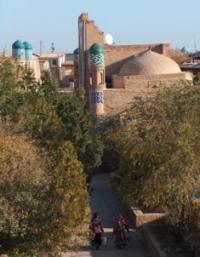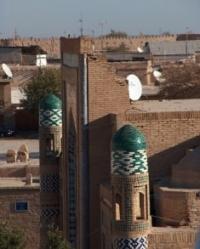You are here
Memorial estate Ichan-Kala.


Excursions on architectural places of interest of Khiva.
"And man became a great understanding,
And he knows many secrets of the post.
And knowledge is the basis of great accomplishments. ”
Rudaki Abu Abdullah Jafar.
Leisure break in Khiva.
As many Eastern cities, Khiva was born "on the water" - in the lower reaches of the Amudarya river and grew up on the irrigated lands of Khorezm oasis. The written sources confirm the considerable age of Khiva. The historical information on Khorezm is given in "Avesta".
The "father of history" Herodot made a mention of Khorezm and the Khorezmian people. Beruni wrote about the ancient agriculture of Khorezm. Archaeological excavations also prove the age of Khiva to be 2500 years old.
All these facts have enabled UNESCO to proclaim Khiva a city-reserve, and its inner part Ichan-Kala has been recognized as a historical monument of the world significance. Khiva is one of the few cities in the world, where the historical building up has actually been preserved; as a matter of fact it is a whole city in the open air.
Monumental architecture of Khiva of the end of the XVIIth - mid-XIXth centuries formed this newly built city and the energy with which the city grew up in the course of only two - three generations of masters fascinates us until now.
What could be ruinous for the urban settlement in different circumstances, namely casual constructions on little spots of land alongside with rather high congestion of population, became a source of unusual diversity of architectural forms.
Ichan-Kala in particular, this most densely populated part of Khiva, became as the fate willed an architectural museum whose buildings represent the best masterpieces of ancient architects.
Traditionally, the spiritual centre was a congregational or Friday mosque. Juma mosque in the Ichan-Kala was also rebuilt at the end of the XVIIIth century; however it preserved the features of classical buildings of the East.
This peculiar one-storied building without portals arches and domes has a big hall with a flat roof resting on 213 wooden carved columns. The biggest madrassah is Mukhammad Amin-khan madrassah. Its double khujras are just fantastic.
The facades are trimmed with coloured bricks designs and majolica tiled bands of vegetable ornament. The doors and pandjara are decorated with a wonderful carving. In the spiritual life of Khiva a special attention was given to the holy places - mazars and mausoleums.
Thus one of the most respected places is a memorial complex of Pakhlavan Makhmud, a furrier by profession, a hero, a philosopher and a poet. After his death his was canonized as pir - a holy patron of Khiva.
Gradually, around the burial place of Pakhlavan Makhmud there grew up a cemetery of the representatives of khan family, while in later period there came into existence the ensemble of the adjoining buildings including winter and summer mosques, commemoration premises and a room for Koran reading.
In the Middle Ages Khiva was also a city of scientists. There existed big scientific centres - astronomy, mathematics, and medicine. There lived and worked great scientists such as Abu Al Khorezmi, Abu Raikhan Beruni, Abu Ali Ibn Sina.
At the court of Abbul Ibn Mammun thee got together the eminent medieval scientists who formed the "Academy of Mamuna". The great scientists of the East were Shermukhammad Munis and Agakhi. Not without reason the city got the name "The Pearl of Khorezm Oasis".
At the times of its prosperity Khorezm was the biggest center of international trade, the key point on the Great Silk Road. The merchants from Volga region, India, Iran came here; from here the trading caravans started their way to Middle East, Eastern Turkestan and China. From Khiva, the roads led to Mongolia and via the Polovetscky steppes to Saksin, a trade place in the mouth of the Volga and further to Russia and Europe.
Archaeologists found new routes of the ancient caravan roads and in particular from Khorezm to Mangishlak and from there by sea to Nizhni Povolzhe proving that Khiva merchants controlled considerable part of trade of Central Asian states with Eastern Europe.
Authority:
http://welcomeuzbekistan.uz
Photos
Alexander Petrov.







